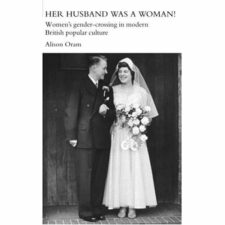The month of April is Sexual Assault Awareness Month, designated to highlighting the ongoing problem of sexual assault in society, and encouraging people to work towards eradicating it. The problem of sexual assault and rape is a topic that has not been ignored by historians with work being done on the extent of sexual assault, its social meaning and consequences, the legal response and prosecution rates, and the impact on women’s lives.
This year’s ‘theme’ is sexual assault on campus, which is perhaps timely given a recent report that 1 in 7 female students in the UK has been sexually assaulted while at university or college (and that 60% of those incidents involved attacks from fellow students). This figure is 1 in 6 in the USA. Even more problematically is the fact that 1 in 4 women in the UK have experienced being raped or sexually assaulted (in the USA it’s 1 in 3).
In my own research on courtship and marriage in the eighteenth and nineteenth century, the appearance of sexual assault is distressingly common and the responses by the community to victims of sexual assault can be quite sickening to the modern reader. What’s more, just like to today where the majority of rape victims know their rapist, the sexual assault of women in the past was generally not by strangers, but by people they knew and often loved.
In 1841, Hannah Magrath sued John Browne for the seduction of her daughter Charlotte. John Browne had known Charlotte since childhood, but they had not seen each other for a number of years after her family moved to Dublin. When Charlotte was 19, they met at the theatre and he began courting her. They regularly attended the theatre together, with Charlotte accompanied by her sister, Anne Jane (who was to become a well-known poet and playwright). One evening, Charlotte and her sister had been to the theatre alone and walked home together. John was waiting outside her house and asked him to walk with her. Anne Jane walked with them. John called a cab to take them home. On arriving at the house, Anne Jane jumped out first and John made the driver drive off with Charlotte in the cab. He then tried to convince her to come into a private house, but she refused to leave the cab. John then used a variety of entreaties- including threatening to kill himself and promising to marry her- to persuade her to have sex with him. Charlotte finally agreed and he dropped her home after the event.
A few months later, Charlotte was in ‘the family way’, but John had disappeared to the country; when she finally heard he was in town, she went to his club to beg him to marry her. John then told her he was married and had been for a number of years. Under the English/ Irish legal system, Charlotte had no redress, but her mother (or employer) was able to sue for seduction and receive payment for ‘loss of services’ caused by the expenses of Charlotte’s pregnancy. Before the trial, Charlotte miscarried, but the suit went ahead. In the course of the trial, her own lawyer described Charlotte’s behaviour in the car that night as ‘disgusting’, but argued that she was an innocent seduced after a long ‘siege’. The defence belittled the idea that she was an innocent at all, arguing:
It is monstrous to suppose that the defendant could have whipped her off against her will; he (Mr Brewster [defence lawyer]) would not be able were he so inclined to do it himself (a laugh). Now he would like to see his learned friend Mr Fitzgibbon at one side of the young lady, with Mr Whiteside [plaintiff’s lawyers] at the other, endeavouring to take off this young lady, and he would venture to say she would make an example of both of them (continued laughter). He did not suggest she was profligate, like one who walked the streets, but that she was a light person who did not reject the advances of men, and no modest women could have acted as she had done.
Ultimately, the jury found for the plaintiff and awarded her mother £700 damages and costs. Yet, the case highlights many of the ambiguities around sexual assault- then and now. Charlotte was assaulted by a man she was dating, who effectively abducted her and refused to take her home, until she ‘consented’ to have sex with him. Yet, that she finally consented, if under coercion, and that she was assaulted by a man she testified in court to having loved, meant that she could never prosecute for rape.
Other women were more unfortunate. The crime of rape was punishable death for much of the nineteenth century, and many people felt that marriage was a more suitable response to the crime than execution. In 1829, at the Tralee Assize, the judge himself suggested the marriage.
Chief Baron O’Grady- young woman would you rather marry the prisoner or hang him? – I would like to give him the benefit of the law, Your Lordship.
A pretty benefit indeed! Is your Parish Priest in town? – I don’t know your honour.
Is your father in town? – He is my Lord.
The father was called to the table.
Chief Baron – would you rather see that man hanged or married to your daughter? – Oh then, I call God to witness, I would rather see him married to my daughter.
Then you consent to the match? – I consent to whatever pleased your Lordship.
Chief Baron- Oh, you must manage the matter yourselves, for I am no matchmaker. (A laugh).
Now let us see what your daughter says to the business; speak to her. [The father proceeded towards the daughter, and, throwing his arms around her neck, gave her an affectionate whisper.]
Chief Baron- Well what does she say; will she marry him?- She consents my Lord.
Chief Baron- Now see what the prisoner says. The gaoler whispered to the prisoner who said he was satisfied.’ The chaplain of the gaol married them.
Despite the woman clearly saying that she wanted ‘the benefit of the law’, she found herself married to her rapist. Ultimately, female consent was often secondary to the needs and desires of men- whether their rapists or judges and fathers. While it is no longer expected today that women will marry their rapists, the right for women to consent still remains under threat- as reflected by the significant number of rapes, where women’s ‘no’ continues to go unheard.
Sources: Freeman’s Journal, 14-15th May 1841; Ballina Impartial, 21/09/1829.
Further Reading
History Group, eds., The Sexual Dynamics of History: Men’s Power, Women’s Resistance (Pluto Press, 1983).
Joanna Bourke, Rape: a History from 1860 to the Present (Virago, 2008).
Garthine Walker, ‘Rereading rape and sexual violence in early modern England’, Gender and History, 10, (1998), pp. 1-25.
Katie Barclay’s research suggests that the extent of sexual violence in courtship in the past has often been underestimated, exasperated with metaphors such as courtship as a ‘siege’, which saw women less as people than things to be conquered. She believes that the continuation of such ideas in modern society encourages the perpetuation of rape and sexual assault today.

